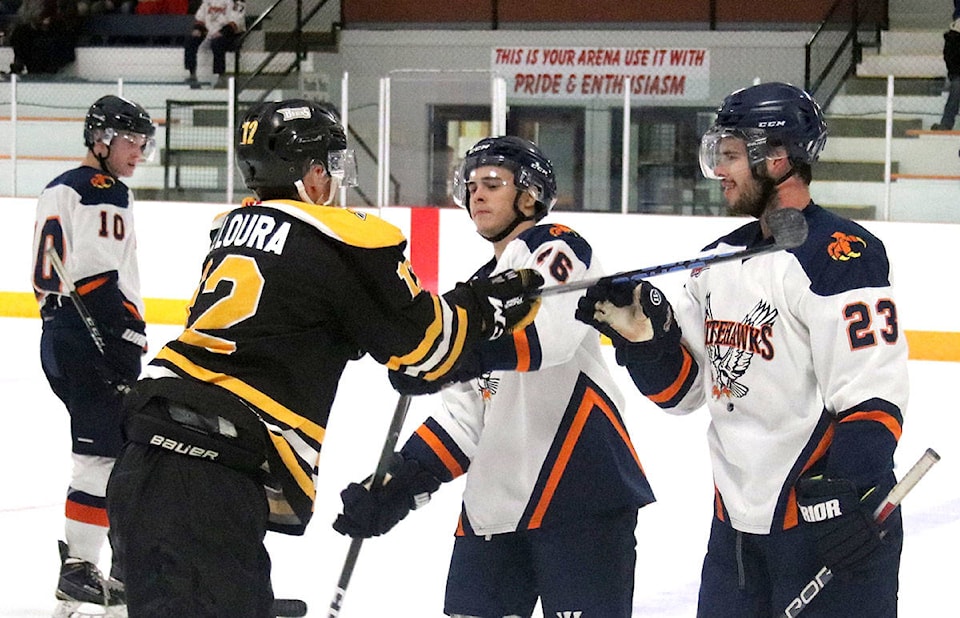The Beaver Valley Nitehawks and all Junior B hockey players across the province will be wearing full face protection next season.
In a memorandum sent this week to BC Hockey’s Junior Committee, Chief Executive Officer Barry Petrachenko stated the BC Hockey board of directors “has mandated that full face protection is required by all BC Hockey Junior B players starting for the 2018-2019 season.”
The requirement will go into effect in the Kootenay International Junior Hockey League (KIJHL), the Vancouver Island Junior Hockey League (VIJHL), Pacific Junior Hockey League (PJHL), and two B.C. teams in the North West Junior Hockey League (Fort St. John Huskies and the Dawson Creek Junior Canucks).
“Our game is faster than it has ever been, and as a result we face increased challenges and responsibilities relative to safety,” said Petrachenko in a release. “We are confident that through this initiative facial and dental injuries will be greatly reduced.”
While KIJHL teams weren’t consulted individually, KIJHL president Bill Ohlhausen says the mandate has been in the works for months, and he fully supports it.
“It’s something that has been developing over the last couple years, and it’s going to cut down on the insurance costs, it’ll cut down on all the facial injuries, and that’s the biggest thing,” Ohlhausen told the Trail Times on Tuesday. “Personally, I think it’s a good thing. Because now they can concentrate on playing the game without worrying about their face and teeth or anything else.”
The change will not apply to the BCHL or the Western Hockey League (WHL), but, as Ohlhausen points out, NCAA teams wear full-face protection, as do Team Canada U18 players, and Major Midget. The Ontario Junior Hockey League also adopted full-face protection in June and is the only one of 10 leagues under the Canadian Junior Hockey League (CJHL) banner to make face-masks mandatory.
The KIJHL has had a mandatory visor rule and full-face protection for 16-year-olds for a number of years, but the KI president says the new measure also bodes well for the league’s future.
“We always have people who don’t like the idea of any advancement, but it’ll probably draw more kids from minor hockey to continue playing hockey because they won’t have to worry about going from a full shield to a half shield and worrying about their face,” added Ohlhausen. “If we can save anybody from getting hit in the face … it only takes one or two to make it devastating.”
The VIJHL Penninsula Panthers’ Governor and General Manager Pete Zubersky unilaterally introduced the change for his team alongside BC Hockey in August, prior to the start of the 2017–2018 season.
“Everybody in this league … can think of a time when a visor or face cage could have prevented an injury,” Zubersky said at the time.
Zubersky met with Petrachenko earlier this year, after VIJHL league meetings resulted in no solid action to adopt full face protection. At the time, Petrachenko said change takes time and BC Hockey will be looking at statistics over the season and will speak with its other junior hockey member associations about further action.
President of the VIJHL Barb Byrne says the league did not adopt full face shields this season, as the team ownership was split on the issue. As well, adopting the policy would require teams to buy new equipment. She said by the time the discussion was on the table, most teams already had their budgets set for the season.
“It’s great news for everybody, especially our players,” said Byrne. “We are a developmental league and we don’t want to be assisting in disabling or disfiguring them.”
Adopting full face protection for the players will have an immediate impact by reducing the amount of face injuries and dental claims. Not only will it ensure better player safety, but Byrne added it will save the league and its teams insurance costs. She said last season saw around four or five different face injuries and approximately $40,000 in dental claims.
“The insurance part of it is really quite expensive,” said Ohlhausen. “We carry an extra insurance policy that is quite a bit of money for each of the teams.”
Between 2010 and 2015, there were 370 dental injuries among visor-wearing players and only eight occurred among fully-masked players. Dental injuries among visor players accrued a cost of $287,775, versus the $7,548 among full face players.
With the new full face protection requirement, the league expects to see a 71% reduction in major medical and dental costs under the Hockey Canada Insurance Program.
